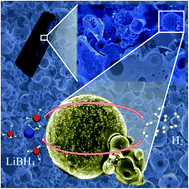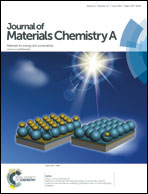Nano-spots induced break of the chemical inertness of boron: a new route toward reversible hydrogen storage applications†
Abstract
Novel LiBH4–metal-loaded carbonaceous foams have been designed to trigger reversible hydrogen storage properties. The metallic nanoparticles favour preferential wetting of LiBH4 on their surface and subsequent nucleation and growth, a configuration in which borate formation is strongly minimized. A cooperative effect between lower boron oxidation and the presence of metallic particles bearing intrinsic high heat capacity (acting as high temperature nanospots) promotes a strong improvement toward the rehydrogenation process, where the chemical inertness of boron has been overcome in this way for the first time. Hence, the LiBH4–M@C-HIPE(25HF) hybrid macrocellular foams (with M = Pd or Au) facilitate a reversible hydrogen storage process with a remnant capacity of about 7.4 wt% H2 (related to LiBH4) after 5 desorption–absorption ) hybrid…” and throughout the article should “absorption” be changed to “adsorption”??>cycles.


 Please wait while we load your content...
Please wait while we load your content...